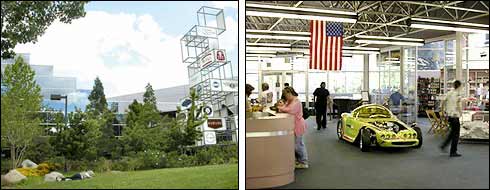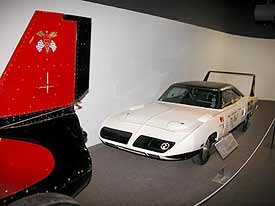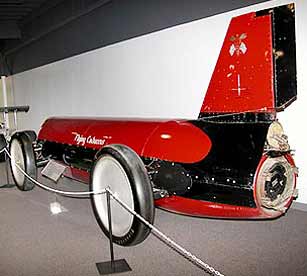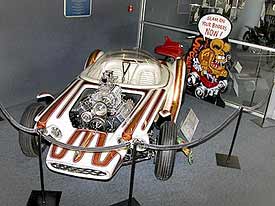
6/7/04
The Biggest Little Car Collection In The World
Part 1

![]() our significant
other thinks you’ve got too many old cars, huh? Imagine how William Harrah’s
six wives felt while he was dragging home nearly 1500 vehicles—which ultimately
filled three huge warehouses outside of Reno, Nevada. Bill was a genuine car
guy, by all accounts, whose collecting goal was to own one example of every
type of car ever made. He almost made it, too. When he died at age 67, fewer
than 60 vehicles remained on his ambitious wish list.
our significant
other thinks you’ve got too many old cars, huh? Imagine how William Harrah’s
six wives felt while he was dragging home nearly 1500 vehicles—which ultimately
filled three huge warehouses outside of Reno, Nevada. Bill was a genuine car
guy, by all accounts, whose collecting goal was to own one example of every
type of car ever made. He almost made it, too. When he died at age 67, fewer
than 60 vehicles remained on his ambitious wish list.
| Bill Harrah's good taste obviously extended to competition cars. The seldom-seen Swamp Rat 20 was campaigned near the end of the 1974 season, after which Bill Harrah called with an offer that Don Garlits could not refuse. The original Army Monza was drag racing's most-dominant single vehicle since the Greer, Black & Prudhomme fueler, winning six of eight NHRA national events in 1975, while cracking both the five-second and 240-mph barriers (5.98; 241.53). |  |
Unfortunately for us, when the legendary hotelier checked out in 1978, he left no specific instructions for the fate of the world-renowned Harrah Collection, which had opened to the public in 1962 and attracted its millionth visitor by 1970. Thus, his 1400-plus cars and trucks went to the Holiday Corporation (parent of Holiday Inns), along with the assets of Harrah’s hospitality empire, in 1980.
You might recall the ruckus raised at the time by noted journalists and serious collectors, led by the late Autoweek publisher, Leon Mandel (who also wrote the definitive Harrah biography, “William Fisk Harrah: The Life and Times of a Gambling Magnate”). Both Mandel and Autoweek had long been based in Reno, so the potential breakup of America’s greatest automobile collection hit particularly hard and close to home. A nonprofit organization was quickly formed to both raise money and pressure Holiday Corp. to postpone selling off the most-important vehicles
 Representing Bonneville’s doorslammer ranks is Jim Frederick’s 1970 Plymouth Superbird, which set and repeatedly reset the B/A record from 1978 to 1982 (216.392). (Photo by Dave Wallace/Good Communications) |
Although these local concerns failed to prevent the sales of more than 1200 valuable and invaluable vehicles, Mandel and other fans did persuade Holiday Corp. to give back 175 important cars (valued at $18 million—in 1980 dollars), as well as Harrah’s irreplaceable research library (worth $3 million). Further, community leaders were inspired to solicit sufficient funding to build a state-of-the-art museum for what remained of the collection, along with future acquisitions of vehicles and related artifacts. Nine years and $9 million dollars later, the National Automobile Museum opened its doors in downtown Reno, literally in the shadow of Harrah’s huge hotel-casino complex.
Having been fortunate enough to experience those endless Sparks, Nevada warehouses both before and after Harrah acquired Winthrop Rockefeller’s world-class auto collection (1975), I was determined to be disappointed with the much-reduced group that greeted my initial visit to the just-opened museum in 1990. Alas, I was. The cleverly constructed “street scenes” and luxurious surroundings could not replace all those hundreds of American cars in my mind. I vowed never to return—and never to spend another night in a Holiday Inn.
 |
Here’s the beast that brought jet engines to Bonneville in 1960, launching the controversial thrust era. By the time owner-driver Nathan Ostich, a Los Angeles physician, sorted out all the bugs and reached 359 mph in his third and final trip to the salt (1963), rival-jet-jockey Craig Breedlove had upped the LSR to 407. A true hot rod, this 6000-pounder was designed by Hot Rod magazine’s tech editor, Ray Brock. Its suspension was built with components from a 3/4-ton 1967 Chevy pickup! (Photo by Dave Wallace/Good Communications) |
 Love ‘em or hate ‘em, it’s nice to know that so many of Ed Roth’s creations are preserved. Be honest, now: How many of you built a model of the Beatnik Bandit? (The author, for one!) (Photo by Dave Wallace/Good Communications) |
Both of those vows have been broken, now. Fourteen years after my first museum tour, I found myself driving past the building and unable to resist the temptation to give it a second chance. I’m glad I did. The eight-dollar admission price seemed reasonable even before I pulled out my wallet; there in the lobby sat no fewer than six Ed Roth creations, including both Beatnik Bandits! Suddenly, all those warehoused Packards and Hudsons and Fraziers were relegated to some back corner of my memory chip—though I did begin wondering whether any of the straight-line race cars I remembered could have possibly survived all that’s gone down in the 27 years since Harrah died.
Three rooms into the four-gallery museum, I still had my fears. Finally, stashed in the back of the final section, I spotted them all: Prudhomme's original Army Monza, whose dominant 1975 season and barrier-busting 5.98/241 efforts I had witnessed up-close (as Drag News editor); Swamp Rat 20, which I'd watched run late in the '74 season (as an employee of AHRA); and Dr. Nathan Ostich's historic jet car, which I'd read about and cheered from afar (as a school kid, sneaking peaks at Hot Rod magazine). Seeing these three gems in such great condition gave me goose bumps. I could've walked out the door a happy camper, right then and there.
|
Contact: Jackie Frady, Executive Director, National Automobile Museum; (775) 333-9300; www.automuseum.org |
I did not, as you can guess from all these photos. There are even more; so
many more that the Large Editor has granted me two installments with which to
share them with you. I hope you’ll tune in next month for the rest of the
cars, along with more about the life and death of the man responsible for what
remains one of the world’s great automotive collections. ![]()
 |
||
Copyright 1999-2004, Drag Racing Online and Racig Net Source